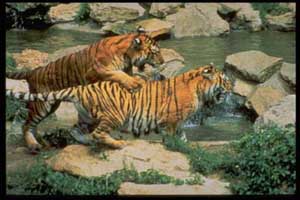|
Travelogues Ranthambore: Tiger at Large
|
|||||||||
|
More on Rajasthan • An Overview • Wildlife
Travelogues
Wildlife
Environment | ||||||||
My wife, Swati and I reached Sawai Madhopur by the Bandra bound Dehradoon Express before dawn, and at daybreak, headed towards the RTDC Hotel Vinayak, at a distance of 7 kms from the station. The 'canters' or vehicles to carry tourists to the National Park leave at 6 a.m. and 3 pm . The canters are open vehicles with a characteristic movement resembling the gait of a horse, slower than a gallop but faster than a trot. After lunch, entry formalities completed, our quest for the tiger at Ranthambore National Park began in earnest.
The lazy yet regal tiger is a crepuscular species, most active just after dawn and just before dusk. This is the best time to attempt to see them. At around 5.30 pm, we finally see a tigress by the waterhole and are lucky enough to watch it for about 5 minutes. Thereafter, all other sightings are tame by comparison. A visit to Ranthambore National Park without a trip to the fort cannot be imagined, so the next afternoon, along with the RTDC hotel manager's 8 year old son and 2 other kids we visit the fort, surrounded by forest cover, almost invisible from a distance, atop the hill adjacent to the Tiger reserve. The Jogi Mahal, which houses the second largest banyan tree in India, is also here. The fort, mainly in sandstone, is 7 kilometers in circumference and was progressively built over a millenium.
The first ruler was Govind, one of the sons of the legendary Prithviraj Chauhan. Because of it's location and structure, it was difficult to conquer and attacks by invaders like Alaudin Khilji, Kutub-ud-din, Feroz Tughlaq, Bahadur Shah of Gujarat were successfully repulsed. The Fort changd hands from the Rajputs to the Moghuls in 1528, and the great emperor Akbar is believed to have stayed at the fort between 1558 and 1559. The Fort was finally gifted by the Mughals in the late 17th century to the Maharaja of Jaipur, who ruled from the magnificent Amer Fort, not far away. The Fort remained with the royal family of Jaipur.
Like Chittaur, Ranthambore Fort also has a history of Jauhar, which was
effected by the queen and all the womenfolk . According to legend, over
a thousand women once committed mass suicide preferring death to falling prey to the armies of a victorious invader.
The fort is in ruins now, but the blend of structures, in varied states of disrepair, speak of a glorious, romantic past. Particularly appreciated is the fact that unlike many forts and historical monuments, there are no guides and no entrance fee, and we have the freedom to explore and revel in wide open spaces, with a tangible sense of history.
Returning to the hotel, the kids persuade us to visit a castle "Jhoomar Baori ", where the other RTDC hotel in Ranthambore is located. A kilometre through the forest we find the erstwhile exotic retreat of a nineteenth century Jaipur king who reportedly had 9 wives and a large harem. The ethnic furniture and exotic setting and decent bar invite us to linger, after which the Jhoomar Baori manager kindly offered to drop us back to the Vinayak, around 4 kms by road. A km from the hotel , in the haze of the gathering dusk we glimpsed a spotted carnivore, probably a leopard. The forest hills surrounding Jhoomar are believed to b home to 6 leopards. Months later as I reminisce about the trip, the romantic imagery of Ranthambore's medieval splendour makes me remember Rene Descartes' (1596 - 1650) remark:
" Travelling is almost like talking with men of other centuries."
|
|||||||||
Editor: Romola Butalia (c) India Travelogue. All rights reserved. |
|||||||||
 In March of the year 2K - President Clinton visited Ranthambore. A year later, a weekend trip found us in the wild and sylvan environs of Ranthambore. The private hunting grounds for the Maharaja of Jaipur, Ranthambore, near the township of Sawai Madhopur, now rightfully serves as a National Park.
In March of the year 2K - President Clinton visited Ranthambore. A year later, a weekend trip found us in the wild and sylvan environs of Ranthambore. The private hunting grounds for the Maharaja of Jaipur, Ranthambore, near the township of Sawai Madhopur, now rightfully serves as a National Park.

 We get to see a variety of deer - the spotted, as well as antlers, Sambar and Nilgai, in ascending order of size. The place abounds with monkeys and peacocks. After two hours of the canter, the striped carnivore still eludes us. A few lucky visitors on the morning safari spotted a couple of mating tigers.
We get to see a variety of deer - the spotted, as well as antlers, Sambar and Nilgai, in ascending order of size. The place abounds with monkeys and peacocks. After two hours of the canter, the striped carnivore still eludes us. A few lucky visitors on the morning safari spotted a couple of mating tigers.
 After three hours at the fort, we start back for the hotel, when a tiger, in all it's elegance, emerges from the forest onto the very road, at a mere distance of 20 feet. Silent and spellbound, we watch as it marks it's territory by moving from tree to tree and urinating. The tiger is possibly what they call a 'floater' - unable to survive the competition of the hardcore jungle, it has been compelled to the fringe of the forest to feed on cattle. This sighting made our trip!
After three hours at the fort, we start back for the hotel, when a tiger, in all it's elegance, emerges from the forest onto the very road, at a mere distance of 20 feet. Silent and spellbound, we watch as it marks it's territory by moving from tree to tree and urinating. The tiger is possibly what they call a 'floater' - unable to survive the competition of the hardcore jungle, it has been compelled to the fringe of the forest to feed on cattle. This sighting made our trip!